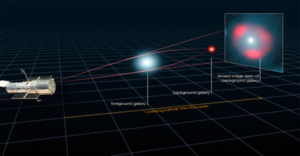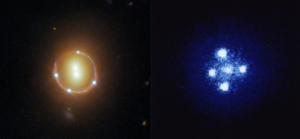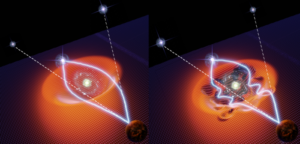The mysterious nature of Dark Matter, an invisible substance that constitutes as much as 85% of the mass of the entire universe, may have finally been solved.
Since its discovery in the 1970s, previous efforts to decode and define dark matter have focused on ultramassive yet invisible particles as the main culprits. However, this latest research seems to show that dark matter may instead be made up of incredible amounts of invisible, ultralight particles that are scattered throughout the cosmos.
Dark Matter Only Interacts with other Matter via Gravity
The Standard Model of Particle Physics, which cosmologists use to measure and quantify the matter within the known universe, has struggled to zero in on Dark Matter. That’s mainly because although its effects can be seen due to its massive gravitational pull on the rest of the objects within the universe, Dark Matter itself does not directly interact with light, making it impossible to see.
Most current theories of Dark Matter have focused on something researchers have termed Weakly Interacting Massive Particles, or WIMPS, which, in theory, are ten times as massive as protons but only interact with other matter through the weak nuclear force. These particles would account for the missing matter in the universe, as well as the indirect effects seen on the bending of light, that let astronomers and physicists know that Dark Matter is there.
Unfortunately, these WIMPS have continually failed their biggest test by being unable to correctly reproduce the positions and brightness of multiply-lensed images in space. Researchers use this method, where a phenomenon known as gravitational lensing bends distant light, to actually see the effects of Dark Matter on light coming from distant stars and galaxies.


More recently, researchers have begun to move away from WIMPS and toward a new type of invisible particle that would account for Dark Matter’s effects while also successfully passing the gravitational lensing test. They are called axions.
Gravitational Lensing Offers Significant Support for ultralight Axions
In the latest attempt to show that the traditional concept of WIMPs is incorrect and that Dark Matter is actually made up of ultralight particles known as axions, a group of researchers has run new tests on gravitational lensing and its effects on the light from distant galaxies. Their results are both successful and fascinating.
Led by Alfred Amruth, a Ph.D. student in the team of Dr. Jeremy Lim of the Department of Physics at The University of Hong Kong (HKU), the press release announcing the new research says, “astrophysicists have for the first time computed how gravitationally-lensed images generated by galaxies incorporating ultralight Dark Matter particles differ from those incorporating ultramassive Dark Matter particles.”


Specifically, they found that the predictions of how WIMPS should affect those images weren’t lining up, but images using the axion model seemed to line up perfectly.
Published in the journal Nature Astronomy, this work was performed in collaboration with Professor George Smoot, a Nobel Laureate in Physics from the Hong Kong University of Science and Technology (HKUST), and Dr. Razieh Emami, a Research Associate at the Center for Astrophysics/Harvard & Smithsonian (CFA).
According to the team, their research shows that “the general level of disagreement found between the observed and predicted positions as well as the brightness of multiply-lensed images generated by models incorporating ultramassive Dark Matter can be resolved by adopting models incorporating ultralight Dark Matter particles.”
Furthermore, the team’s research showed that their models, which incorporate axions, “can reproduce the observed positions and brightness of multiply-lensed galaxy images.” It’s an important breakthrough and one that they say perfectly reproduces the “crinkly” rather than “smooth” nature of spacetime around galaxies.


FINDINGS SUPPORT THE NEW THEORY OF DARK MATTER IN A NUMBER OF WAYS
These findings are significant for a number of reasons. First, they show that the problems with gravitationally generated images of distant galaxies when using WIMP models disappear when those models replace WIMPS with these ultralight particles. Second, they rectify the problem previous researchers have had when hunting for WIMPs in the laboratory setting.
“The possibility that Dark Matter does not comprise ultramassive particles, as has long been advocated by the scientific community, alleviates other problems in both laboratory experiments and astronomical observations,” explains Dr. Lim. “Laboratory experiments have been singularly unsuccessful at finding WIMPs, the long-favoured candidate for Dark Matter.”
Lim also notes that these types of experiments are “in their final stretch,” and if they are not found in the upcoming DARWIN experiments, WIMPs will be left “with no place to hide if not found.”
The researchers also note that the lack of satellite galaxies surrounding the Milky Way has likewise put a hamper on the case for WIMPs as Dark Matter. However, this discrepancy is perfectly explained if those ultramassive particles are replaced with ultralight ones.
“If Dark Matter comprises ultramassive particles, then according to cosmological simulations, there should be hundreds of satellite galaxies surrounding the Milky Way,” explains study co-author Professor Tom Broadhurst, who is a visiting professor at HKU. “However, despite intensive searches, only around fifty have been discovered so far.”
But, Broadhurst counters, “If Dark Matter comprises ultralight particles instead, then the theory of Quantum Mechanics predicts that galaxies below a certain mass simply cannot form owing to the wave interference of these particles.” This, Broadhurst says, would explain “why we observe a lack of small satellite galaxies around the Milky Way.”
Time to Reconsider the Existing Paradigm of Dark Matter
Given their latest research, combined with the failed efforts to find evidence of WIMPS to explain Dark Matter, the team behind the potentially paradigm-shifting findings says it may finally be time to take a fresh look at ultralight particles and move away from ultramassive ones.
“Incorporating ultralight rather than ultramassive particles for Dark Matter resolves several longstanding problems simultaneously in both particle physics and astrophysics,” says Amruth. “We have reached a point where the existing paradigm of Dark Matter needs to be reconsidered.”
“Waving goodbye to ultramassive particles, which have long been heralded as the favoured candidate for Dark Matter, may not come easily, but the evidence accumulates in favour of Dark Matter having wave-like properties as possessed by ultralight particles,” the researcher adds.
The team also notes that there may be some help on the way from the James Webb Space Telescope that will put ultramassive particle theories to rest once and for all, shifting the entire field toward looking for ultralight ones instead.
“Understanding the nature of particles that constitute Dark Matter is the first step toward New Physics,” said Professor Smoot. “This work paves the way for future tests of Wave-like Dark Matter in situations involving gravitational lensing. The James Webb Space Telescope should discover many more gravitationally-lensed systems, allowing us to make even more exacting tests of the nature of Dark Matter.”
Christopher Plain is a Science Fiction and Fantasy novelist and Head Science Writer at The Debrief. Follow and connect with him on Twitter, learn about his books at plainfiction.com, or email him directly at christopher@thedebrief.org.

